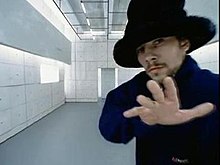Virtual Insanity- A Victim of its Own Warning
If you’ve been on the internet over the last couple of weeks, it’s been almost impossible to scroll without seeing some variation of the famous “Virtual Insanity” music video. Jamiroquai’s 1996 hit song has recently seen new life as the subject of a slew of viral memes. The group’s undisputed magnum opus serves as a warning—one that may be more relevant to current times than it was in the 1990s. The song warns the listeners that their unconditional love for technological innovation will only lead to…. you guessed it, “Virtual Insanity”, among other problems. It’s honestly incredibly ironic that most people today only know the song due to the technology that Jamiroquai warned us about almost 27 years ago.
The lyrics tell the story of a dystopian future where our reliance on technology has left us disconnected from the real world. The lyrics tell a bleak story about how dangerous our love of technology is, as well as how they view such priorities as “useless” and “twisting” when compared to real life. The song warns of technology’s tendency to harm the environment as well, citing that it isn’t “nature’s way.” They provoke the listener’s thoughts as well, by implying that all of that will lead to a “future made of virtual insanity,” and a future that is ultimately void of perception and real feeling. “Now there is no sound, for we all live underground.”
Virtual Insanity’s music video is undoubtedly one of the most innovative music videos of all time. So much so, that in a 2009 MTV poll on music videos that “broke the rules,” it was voted number nine of all time. The video featured Jamiroquai’s front man, Jay Kay, weaving in between pieces of furniture that appeared to be moving themselves around a futuristic room. Jay Kay incorporated numerous unorthodox dance moves into this sequence while placing himself in many iconic positions, such as the now-famous shot of him reaching his hand toward the camera. The appearance of moving furniture was accomplished by moving the walls of the room around a set floor, which produced the optical illusion that it was the contents of the room moving, rather than the room itself.
This video’s first real time being viral was in 1997 when it was first aired on the network MTV. The video was so popular and well received that it went on to be nominated for ten awards in the 1997 MTV Video Music Awards (VMAs) and ended up winning four of them, most notably “Best Video of the Year.” For 1997 standards, this was about as “viral” as a video could get. Of course, the internet was about to blow up at the turn of the century and “Virtual Insanity” was about to go along for the ride. In 2005 the video sharing website YouTube burst onto the scene, and five years later, in 2010, the music video for “Virtual Insanity” was first uploaded to the site where it has amassed over 227 million views since. The advent of new means to share virtual content had directly resulted in the song being introduced to a new generation of listeners over a decade after the original release.
In the 13 years since 2010, all the way up to the present, there have been several references to the song in popular culture, as well as in the aforementioned memes. One relevant example that has turned into a meme itself is the parody of the video that was present in an episode of the American animated show “Family Guy.” The parody features a character from the show reenacting the music video. However, the once meaningful lyrics were replaced with jokes about the characters and the video itself. Recently on Instagram, gags that take aspects of the video out of context have also gained popularity. The main difference between these memes and the original content is that memes remove all meaning from the song. Rather than telling a story about the downfalls of technological prioritization, they simply poke fun at the music video in a way that is generated to produce views.
All of the meaning is gone, which is something that the song talks about when referencing how “now there is no sound” (assuming ability to derive meaning requires perception). The song going viral forced it to be recognized for all the wrong reasons. The song speaks against the dumbing down of expression for the sake of technology. Sure, the average attention span is down significantly since 1997 and the newer generation prefers to watch ten second memes, but this is exactly what Jamiroquai is talking about. A society that is so hyper-fixated on evolving for technologies sake will eventually reach the point
where there is no longer a meaning behind it, much like “Virtual Insanity” has lost its meaning in the collective conscience of pop-culture. How much meaning are we really willing to sacrifice to “keep up with the tech?” Jamiroquai asked it almost three decades ago, and we’re living with it now.




Great article, I cannot beleive how little mention there is anywhere about the lyrics in this song, if you look in wikipedia it mentions nothing of the meaning of the lyrics. thank you for bringing the real meaning to the table.